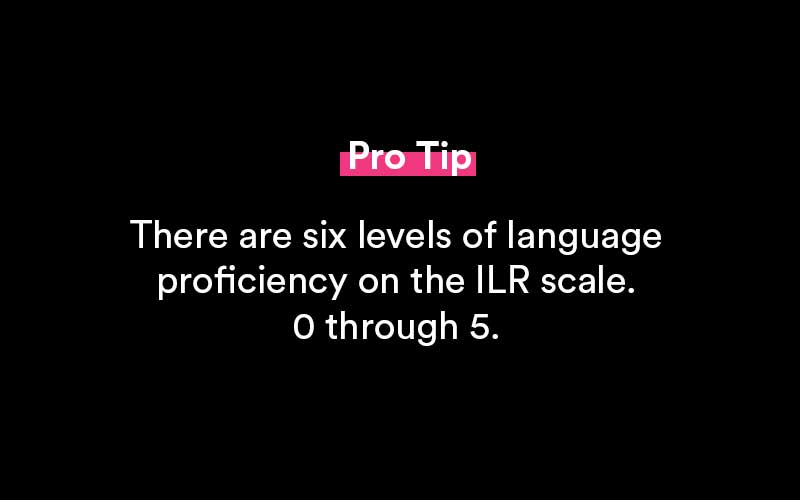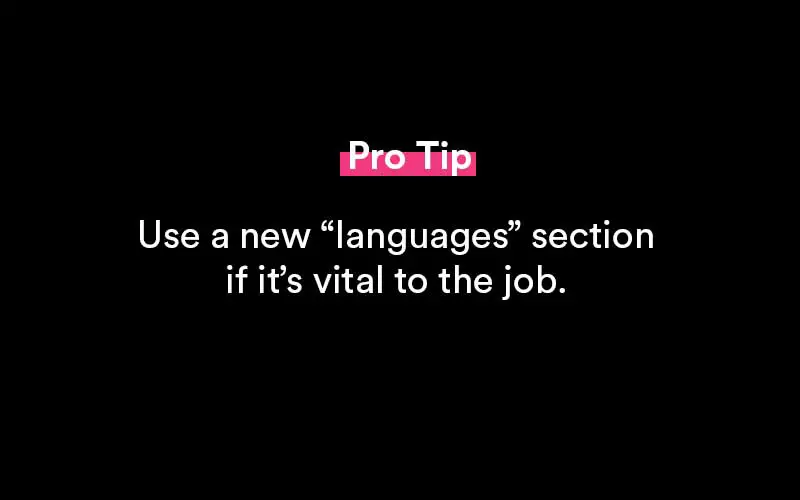Language Proficiency Levels and Including it on a Resume
What are language proficiency levels? Thousands of languages are spoken by individuals from all walks of life across the world. You might be wondering how to measure your language abilities and correctly mention them on a resume if you've acquired another language or many languages during your life.

What are levels of fluency?
The phrase "fluency levels" refers to preset degrees of language abilities that are related to a person's ability to speak, write, and read a foreign language. On a résumé, your degree of fluency aids potential employers in determining whether or not you're qualified for a given job. Online tests and guides that help you understand your degree of fluency in a foreign language can be used to measure your level of fluency.
There are two frequently utilized proficiency frameworks in the United States. The Interagency Language Roundtable (ILR) scale and the American Council on the Teaching of Foreign Languages (ACTFL) scale are two examples (ACTFL).
There are six levels of language proficiency on the ILR scale:
- 0 - No proficiency. This implies that you don't know much about the language or only know a few words.
- 1 - Basic understanding. Can read/write basic sentences. Not a proficient language. Or elementary proficiency. Knowing how to compose simple phrases, which can contain frequent inquiries and responses commonly used by visitors, is required to demonstrate this level of fluency.
- 2 - Limited proficiency/limited working proficiency. You can conduct limited social discussions and comprehend basic orders at level two. Can form basic sentences.
- 3 - Professional proficiency. Level three indicates that you have a good understanding of the language and can contribute significantly to the job, however, you can have a noticeable accent and require assistance with complex vocabulary. Fairly extensive vocabulary.
- 4 - Full professional proficiency. Professional working proficiency in this language. On the ILR scale, level four abilities are what most companies want to see on a resume. It implies you can hold sophisticated discussions and have a solid grasp of the language, albeit there can be some misconceptions or occasional errors.
- 5 - Ability to communicate in a native or bilingual manner. Level five denotes complete fluency in a language. You were either raised speaking the language or have practiced it for a long time. Your accent is either completely absent or hardly discernible.
Novice, Intermediate, Advanced, Superior, and Distinguished are the five primary fluency levels on the ACTFL scale. Low, medium and high proficiency levels are among these levels.
Take language tests to determine which foreign languages are your most proficient language.
Here's a graphic representation of how these two scales' levels compare:
- Novice (Low/Mid/High) — 0/0+/1
- Intermediate (Low/Mid/High) — 1+
- Advanced Low — 2
- Advanced Mid — 2+
- Advanced High — 3/3+
- Superior — 4+
CEFR refers to the European format for language proficiencies. This includes A1, A2, B2, C1, and C2. Only use these levels when applying to positions in another country.

Why is listing proficiency important on a resume?
You should notify potential employers about your level of language competence as a job seeker for numerous reasons:
- The work requires your linguistic abilities.
- You want to stand out as a more appealing prospect.
- You want to demonstrate that you're a quick study.
- Your expertise might be beneficial to the company's future expansion.
The relevance of language skill levels on a resume/CV must be obvious to the recruiter. Your aim is to demonstrate that as a potential bilingual or multilingual employee, you can offer value to the organization.
These are valuable talents to include on a resume since they demonstrate your capacity to speak more effectively in situations where others would have difficulties.
How to include language fluency on a resume
When determining how to incorporate your multilingual abilities on a resume, follow these steps:
Highlight your skills in a new section
When applying for a job that demands knowledge of a foreign language, you'll want to make sure that your multilingual abilities are prominently shown. Rather than including it in your abilities area, where it can be ignored, make a separate part that defines your degree of fluency. If you just know one foreign language, it's preferable to put it in the skills area. However, for many people who wish to highlight their abilities, a separate section is the ideal option.

Display the language skills after education
The heading, professional skills, job experience, and education are the major components of a resume. If you don't have another core component at the conclusion, put your language section after the education portion. Because it follows the natural flow of the resume, the part is considerably more apparent to the hiring manager.
List languages showing your proficiency
You've found the ideal location to incorporate your language skills, and you're ready to list them utilizing a single language framework. Many language frameworks or guidelines exist that can help you determine your degree of skill in a foreign language. When announcing your skills, though, you should only utilize one of those scales for consistency.
Begin with the most proficient languages
You could be able to communicate in a variety of languages. You most likely have a skill level that varies from language to language. It is recommended to include your most fluent language first on your resume, then the remainder in descending order.
Tips for listing languages on a resume
Now that you know how to mention your degrees of language proficiency on a resume, let's go over some pointers to be sure you've correctly reflected your abilities.
Keep in mind the significance of being truthful about your talents. It's generally better to leave off any items you're about to write or add if you have any doubts regarding them. The following are the most crucial guidelines for mentioning languages on a resume:
Don't overstate skills
For a variety of reasons, this is a poor idea. When you tell your employer that you have talents that are greater than your real abilities, you are lying about your abilities. You'll have to show how well you know the language at some time, which can be humiliating if you're not as proficient as you once claimed. You also don't want to come across as if you've been lying. When in doubt, it's better to underestimate rather than exaggerate your language abilities.
Include your native or first language
When adding several languages on a resume, it's best to list English as your native language if you were born and raised in an English-speaking family. If you leave this information off your resume, you risk causing misunderstanding. Employers can think you speak English based on the fact that you submitted your resume in that language.
Leave extinct languages off
Though it can be tempting to include Latin on your resume since you use it frequently in your field of work, you should avoid it. If you're applying for a Latin-based employment, you can wish to add it under specific situations, but it's not required otherwise.
Avoid using years when referencing fluency
When describing your linguistic abilities, it's preferable to avoid using the phrase 'years.' This is because your degree of skill in a language is not determined by your age. Even if you took French for four years in high school, you don't have the same abilities as someone who has earned the Level 4 (IRL) designation.
Mention you're bilingual
In addition to including a specific language section on your resume, you should emphasize your bilingualism in your summary. Knowing this phrase right away helps the hiring manager prepare for future information regarding your language skills, which can be located lower down the resume/CV.
Remove languages
One-page resumes are the most frequent. If you're running out of room and being multilingual isn't a must-have skill for the job, consider eliminating the language part entirely. If required, you can always bring it up again in the cover letter or during the interview.
Examples of listing languages on a resume
Under "additional skills," mention:
One language
Level 3 (IRL) Spanish
Multiple languages
English - Level 5 (ILR)
German - Level 3+ (ILR)
Have a language skills section
You can list a "language skills" on the resume if language is a key part of the job description. Example:
Language Skills
Professional working Spanish - 4
The language proficiency level is included as a "4."

Similar resources
- Sales Skills
- Functional Resume
- Interpersonal Skills
- Resume Format
- Volunteer Work on Resume
- How to List References on a Resume
- What is a CV?
- Resume Summary Examples
- Language Proficiency Levels
- Professional Background
- How to Pout Shadowing on a Resume
- Job Hunting
- How Far Back Should a Resume Go
- How to List Publications on Resume
- Skills List for the Resume
Popular Resources

Featured
35+ Phone Interview Questions & Best Sample Answers
Phone interviews have become a core part of the process when attempting to find a secured placement for an open position. Companies receive massive responses from potential candidates for any..

Featured
12+ Best Questions To Ask A Recruiter
Concerning a job search, you might receive numerous offers from your recruiters. Before you choose one, you need to assess all the conditions, for which it is vital that you know everything associated with the offered position..

Featured
Answering "What Makes You Unique" In A Job Interview
Answering this question during a job interview requires more than knowing why you are unique as an individual. Yes, the true scientific answer is made up of two main components: your..

Featured
250+ Ice Breaker Questions for Life
An ice breaker question is a question that’s asked from one person to another person in order to act as a conversation starter. It brings a connection...

Featured
10 Best Answers to "What Motivates You?"
Open-ended questions like “What motivates you?” can elicit a deer-in-the-headlights reaction from job candidates if they are unprepared. It’s a broad question and can leave the interviewer..

Featured
Answering "How Did You Hear About This Position" In An Interview
A lot of interviewers ask this question - how did you hear about this position? This way they can judge you if you are a passive or an active job seeker..

Featured
8 Best Thank You Emails After an Interview (Samples, Free Templates)
Writing a thank you note after an interview says a lot about you as a potential employee. Most notably, it says that you care about the opportunities presented..

Featured
Writing a Resignation Letter (How To Write It, Samples)
Writing the perfect letter of resignation is more of an art than it is a science. And we’re going to cover how to master that art form in this full guide..

Featured
How to End a Letter (Example Salutations, Sign Off's)
Knowing how to end a business note or email is an important skill to develop. It helps portray a sense of confidence, respect and tone to your message..
